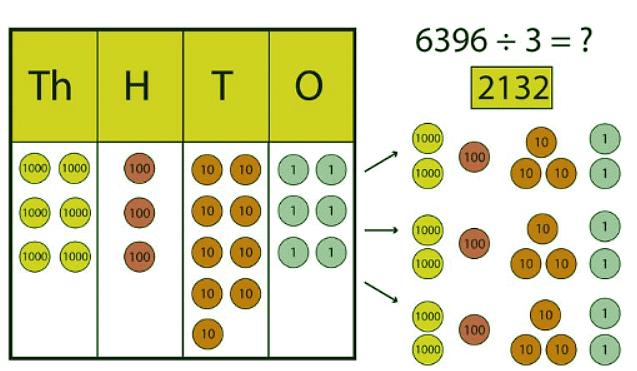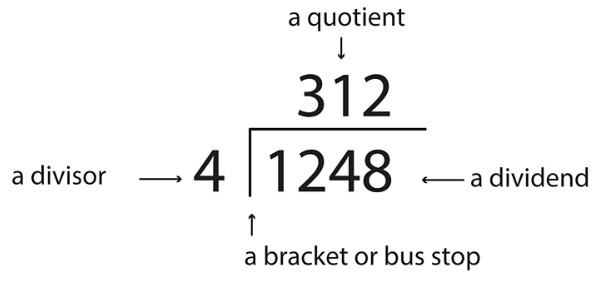Year 5 Exam > Year 5 Notes > Year 5 Mathematics > Divide up to 4 digits by 1 digit
Divide up to 4 digits by 1 digit | Year 5 Mathematics PDF Download
How to Divide 4-Digit Numbers
Division is splitting a number into equal parts. When dividing a 4-digit number by a 1-digit number, you break down the calculation based on the place value of each digit.Examples
Example: 1
What is 6396 divided by 3?
In this example, we'll break down the calculation using place value counters.
The place value chart displays the number 6396, comprising 6 thousands, 3 hundreds, 9 tens, and 6 ones. To divide this by 3, consider the values in each column:
- 6 thousands divided by 3 equals 2 thousands.
- 3 hundreds divided by 3 equals 1 hundred.
- 9 tens divided by 3 equals 3 tens.
- 6 ones divided by 3 equals 2 ones.
Therefore, 6396 ÷ 3 = 2132.
- Here's 6396 depicted in a place value chart, showing 6 thousands, 3 hundreds, 9 tens, and 6 ones. To perform the division, you arrange the counters into groups of 3.

- Dividing the counters into groups of 3 results in: 6 thousands divided by 3 equals 2 thousands, 3 hundreds divided by 3 equals 1 hundred, 9 tens divided by 3 equals 3 tens, and 6 divided by 3 equals 2 ones. Thus, 6396 ÷ 3 = 2132.
Example: 2
What is 1248 divided by 4?
This is dividing a 4 digit number by a 1 digit number, but without the place value counters.
- 12 hundreds divided by 4 is 300, four tens divided by 4 is 10, 8 divided by 4 is 2. 300 plus 10 plus 2 equals 312.

- Another method to represent this is with a bracket or division symbol. In division, we refer to the dividend (the number being divided), the divisor (the number we divide by), and the quotient (the result of the division). Notice how the digits of the dividend and quotient are aligned in this calculation, similar to column addition and subtraction.

- To start the division, divide the first digit of the dividend by the divisor. If 1 cannot be divided, divide 12 by 4, which equals 3.

- Repeat this process for each digit of the dividend.
Example: 3
What is 6324 divided by 6?
- 6 divided into 6 thousands goes exactly once, with no remainder.
- 6 cannot be divided into 3 hundreds — there isn't even one six in three! So, move the 3 hundreds to make 32 tens.
- 6 divided into 32 tens goes 5 tens with 2 tens left over.
- 6 divided into 24 ones goes exactly 4 ones, with no remainder.
The document Divide up to 4 digits by 1 digit | Year 5 Mathematics is a part of the Year 5 Course Year 5 Mathematics.
All you need of Year 5 at this link: Year 5
|
45 videos|51 docs|15 tests
|
FAQs on Divide up to 4 digits by 1 digit - Year 5 Mathematics
| 1. How do you divide a 4-digit number by a 1-digit number? |  |
Ans. To divide a 4-digit number by a 1-digit number, you start by dividing the leftmost digit of the dividend by the divisor. If the divisor is larger than the leftmost digit, you move to the next digit and combine it with the leftmost digit to form a number larger than the divisor. Continue this process until you have divided all digits.
| 2. What is the importance of understanding division concepts in mathematics? |  |
Ans. Understanding division concepts in mathematics is important as it helps in solving real-world problems involving sharing, grouping, and fair distribution. It also enhances problem-solving skills and improves overall mathematical fluency.
| 3. Can you explain the role of multiplication in division? |  |
Ans. Multiplication is closely related to division as multiplication is the inverse operation of division. When dividing a number, you are essentially finding how many times a divisor can be multiplied to get the dividend. Understanding multiplication can help in performing division more efficiently.
| 4. How can division be applied in everyday life situations? |  |
Ans. Division can be applied in everyday life situations such as dividing a pizza among friends, sharing a certain amount of money equally among family members, or calculating the number of days in a week. It helps in fair distribution and problem-solving.
| 5. What are some common mistakes to avoid when dividing numbers? |  |
Ans. Some common mistakes to avoid when dividing numbers include forgetting to carry over the remainder, incorrectly placing the decimal point in decimal division, and not double-checking the final answer for accuracy. Practice and attention to detail can help in avoiding these mistakes.
Related Searches















